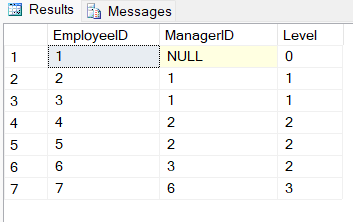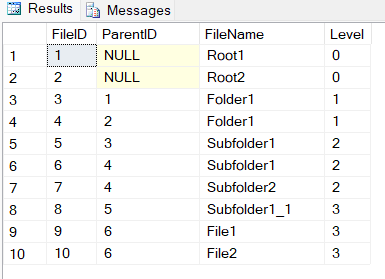What are Recursive queries in SQL?
Recursive queries in SQL are queries that involve self-referential relationships within a table. They allow you to perform operations that require iterative processing, enabling you to traverse and manipulate hierarchical data structures efficiently.
Syntax of Recursive Queries
WITH RECURSIVE cte_name (column1, column2, ...) AS (
-- Anchor member
SELECT column1, column2, ...
FROM table_name
WHERE condition
UNION ALL
-- Recursive member
SELECT column1, column2, ...
FROM table_name
JOIN cte_name ON join_condition
WHERE condition
)
SELECT column1, column2, ...
FROM cte_name;
Recursive queries consist of two main components,
1. Anchor Member
The anchor member establishes the base case or initial condition for the recursive query. It selects the initial set of rows or records that serve as the starting point for the recursion. The anchor member is a regular SELECT statement that defines the base case condition.
2. Recursive Member
The recursive member defines the relationship and iteration process in the recursive query. It specifies how to generate new rows or records by joining the result of the previous iteration with the underlying table. The recursive member includes a join condition that establishes the relationship between the previous iteration and the current iteration. It also includes termination criteria to stop the recursion when certain conditions are met.
Example 1. Hierarchical Data - Employee Hierarchy
Consider the "Employees" table, which has the columns "EmployeeID" and "ManagerID." The employees reporting to a certain manager will be retrieved via a recursive query that traverses the employee hierarchy.
-- Create the Employees table
CREATE TABLE Employees (
EmployeeID INT,
ManagerID INT
);
-- Insert sample data
INSERT INTO Employees (EmployeeID, ManagerID)
VALUES (1, NULL),
(2, 1),
(3, 1),
(4, 2),
(5, 2),
(6, 3),
(7, 6);
-- Perform the recursive query
WITH RECURSIVE EmployeeHierarchy (EmployeeID, ManagerID, Level) AS (
-- Anchor member: Retrieve the root manager
SELECT EmployeeID, ManagerID, 0
FROM Employees
WHERE ManagerID IS NULL
UNION ALL
-- Recursive member: Retrieve employees reporting to each manager
SELECT e.EmployeeID, e.ManagerID, eh.Level + 1
FROM Employees e
JOIN EmployeeHierarchy eh ON e.ManagerID = eh.EmployeeID
)
SELECT EmployeeID, ManagerID, Level
FROM EmployeeHierarchy
Output

Example 2. Hierarchical Data - File System Structure
Consider a table called "Files" that has the columns "FileID" and "ParentID," which describe the hierarchy of a file system. To retrieve all files and their hierarchical structures, we'll utilize a recursive query.
-- Create the Files table
CREATE TABLE Files (
FileID INT,
ParentID INT,
FileName VARCHAR(100)
);
-- Insert sample data
INSERT INTO Files (FileID, ParentID, FileName)
VALUES (1, NULL, 'Root1'),
(2, NULL, 'Root2'),
(3, 1, 'Folder1'),
(4, 2, 'Folder1'),
(5, 3, 'Subfolder1'),
(6, 4, 'Subfolder1'),
(7, 4, 'Subfolder2'),
(8,5, 'Subfolder1_1'),
(9,6, 'File1'),
(10,6, 'File2');
-- Perform the recursive query
WITH RECURSIVE FileStructure (FileID, ParentID, FileName, Level) AS (
-- Anchor member: Retrieve root level files
SELECT FileID, ParentID, FileName, 0
FROM Files
WHERE ParentID IS NULL
UNION ALL
-- Recursive member: Retrieve nested files
SELECT f.FileID, f.ParentID, f.FileName, fs.Level + 1
FROM Files f
JOIN FileStructure fs ON f.ParentID = fs.FileID
)
SELECT FileID, ParentID, FileName, Level
FROM FileStructure;
Output
File Structure Hierarchy Output

The recursive query continues to iterate until the termination criteria are satisfied, generating new rows or records in each iteration based on the previous iteration's results. The result set of a recursive query includes all the rows or records generated during the recursion.
Recursive queries are typically used to work with hierarchical data structures, such as organizational charts, file systems, or product categories. They allow you to navigate and analyze the nested relationships within these structures without the need for complex procedural code or multiple iterations.
Recursive queries are supported by several database systems, including common SQL-based systems like PostgreSQL, MySQL (with the help of Common Table Expressions or CTEs), and Microsoft SQL Server (with the help of the WITH RECURSIVE keyword).
Advantages of Recursive Queries
- Handling Hierarchical Data: Recursive queries provide a straightforward and efficient way to work with hierarchical data structures, such as organizational charts, file systems, or product categories. They allow you to retrieve and navigate the nested relationships in a concise manner.
- Flexibility and Adaptability: Recursive queries are adaptable to various levels of depth within a hierarchical structure. They can handle any level of nesting, making them suitable for scenarios where the depth of the hierarchy may vary.
- Code Reusability: Once you have defined a recursive query, it can be easily reused for different hierarchical structures within the same table, saving development time and effort.
- Simplified Query Logic: Recursive queries eliminate the need for complex procedural code or multiple iterations to traverse hierarchical relationships. With a single query, you can retrieve the entire hierarchy or specific levels of interest.
- Improved Performance: Recursive queries are optimized by the database engine, allowing for efficient traversal of self-referential relationships. The engine handles the iterative process internally, leading to better performance compared to manual traversal techniques.
Disadvantages of Recursive Queries
- Performance Impact on Large Hierarchies: While recursive queries offer performance benefits, they can become slower when dealing with large hierarchies or deeply nested structures. The performance impact increases as the level of recursion, and the number of records involved in the recursion grow.
- Limited Portability: Recursive queries may not be supported or may have varying syntax across different database systems. This can limit the portability of your SQL code when migrating to a different database platform.
- Complexity in Maintenance: Recursive queries can be complex to understand and maintain, especially for developers who are not familiar with recursive programming concepts. Code readability and documentation become crucial to ensure clarity and ease of maintenance.
- Recursive Depth Limitations: Some database systems impose limitations on the maximum recursion depth allowed for recursive queries. This can restrict the usage of recursive queries in scenarios with extremely deep hierarchies.
- Potential for Infinite Loops: Incorrectly constructed recursive queries can lead to infinite loops, causing the query execution to hang or consume excessive system resources. It is essential to carefully design and test recursive queries to avoid this issue.
HostForLIFE.eu SQL Server 2019 Hosting
HostForLIFE.eu is European Windows Hosting Provider which focuses on Windows Platform only. We deliver on-demand hosting solutions including Shared hosting, Reseller Hosting, Cloud Hosting, Dedicated Servers, and IT as a Service for companies of all sizes.
